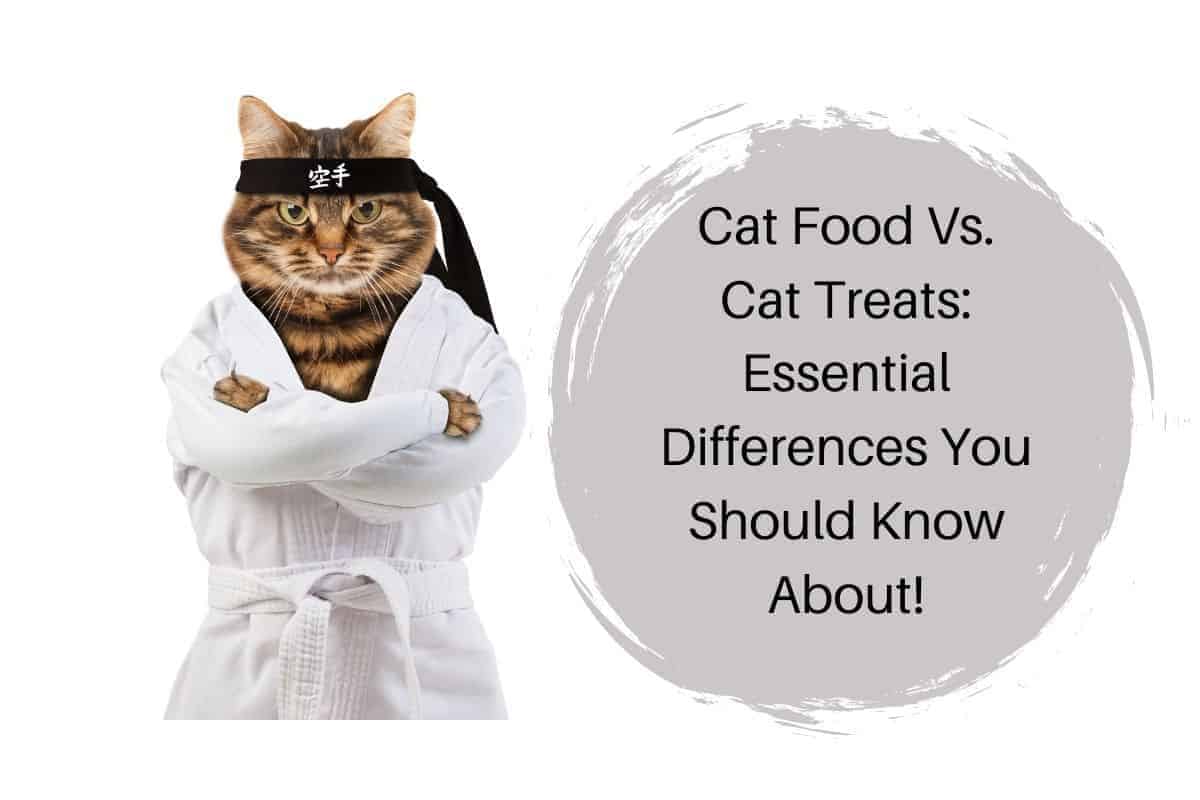What is the difference between dry cat food and cat treats? Why is one of these a dull part of their daily diet and the other a miraculous food that tastes like manna from heaven? We haven’t done taste tests, but the differences are quite broad!
The difference between cat food and cat treats is the same as the difference between your dinner and junk food. Cat food is designed to be nutritionally balanced and provide everything your cat needs to be healthy. On the other hand, cat treats are designed to be tasty treats given in moderate amounts.
Continue reading as we look at the essential differences between the food and treats you provide your kitty with and if the treats are bad for your furry friend’s health!
The Difference Between Cat Food And Cat Treats
Cat Food
Unlike commercially prepared cat foods, cat treats are not complete or balanced. Some of the most popular cat treats contain up to 85% protein, far higher than the amount of protein found in an appropriately balanced and nutritional cat food formulation.
Your cat needs its diet to include the right balance of the six major nutrient groups to maintain optimal health. These nutrient groups are protein, fats and oils, minerals, vitamins, carbohydrates, and water. Any good quality cat food needs to contain these six nutrient groups for your cat to benefit most out of their meals.
Many other types of cat food are designed to also meet specific needs, for example, if your cat is pregnant, senior, or a growing kitten. The general and most important rule in terms of ingredients is just as important as the kind and quality of ingredients.
When looking at food that lists meats (protein) as the first ingredient and has a minimal number of ingredients usually indicates low levels of processing. If your cat is on a special diet for other reasons, such as medical, the protein source should be listed first, followed by other ingredients in the order of their percentage of total weight.
Cat Treats
On the other hand, cat treats are completely the opposite of what your cat needs out of their regular food. Instead of your cat indulging in nutritionally balanced food, the ingredients in treats include inappropriate ingredients like carbohydrates, mystery meats, and plant-based protein.
Carbohydrates are not essential to your cat’s diet. Crunchy cat treats typically contain 25-50% carbohydrates. These huge amounts of carbohydrates will break down into sugar, and the excess sugar will raise insulin and form a resistance. Excessive sugar is stored in your cat’s body in the form of fat.
The mystery meats in treats come from dead, diseased, dying, and disabled animals. These meats are allowed legally in pet food as long as they are heated to very high temperatures to destroy bacteria and any living germs.
The bacteria may be destroyed, but the euthanasia drugs may not be. There have been many recalls for kibble, canned cat food and even cat treats for containing euthanasia drugs. This is extremely harmful to your cat’s health!
Lastly, the plant-based protein. Cats are carnivores, so it’s almost unnecessary to state that they need meat to survive. Meat, bones, and organs provide the perfect balance of amino acids, fat, vitamins, trace minerals, and protein. The thing is, cats are unable to convert plant materials into essential nutrients.
These three ingredients are all combined to attract and interest your cat in eating its treats, but it is barely to never beneficial for them. All these ingredients will result in unnecessary and unhealthy weight gain and disturb the regular nutritional balance in your cat’s body.
Are Cat Treats Bad For Cats?
Most cat treats are bad for cats because they contain high amounts of carbohydrates and low-quality meat ingredients. Cats get addicted to treats because of the flavor enhancers sprayed on them. Cats are not grain-eaters by choice, so commercial companies would spray meat flavor on the otherwise bland treats.
Cat treats are all the tasty things you would feed to your kitty to treat him. Cat treats can include milk, catnip, cooked meat or fish, or even biscuit treats! Treats should only make up five to ten percent of your cat’s required daily calorie intake. Things that will change or influence your cat’s calorie intake are their age, breed, health conditions, and overall fitness level.
When it comes to human food, we as cat parents know that your cat’s adorable begging eyes could be almost impossible to resist. We then tend to feed them out of our plate out of pure love and affection. This is a big no-no, as feeding them too many pieces of human food can encourage them to start stealing from the kitchen, increasing the chances of eating possible toxic food.
Also, treating your cat with dairy products can be harmful since most adult cats are actually lactose intolerant! They will certainly not benefit from milk.
Too many catnip treats are never a good idea neither. When it comes to the fine art and entertainment of giving catnip to your cat as a treat, we like to hold on to the idea that catnip is a natural plant and is not addictive.
The statement above may be true, but if your cat indulges too much catnip, it could cause vomiting and diarrhea. If this happens, you should remove the catnip immediately and give your cat some time to recover. Rationalizing the portions of catnip you give to your kitty could actually benefit them, as too much exposure to catnip also dulls the effects and experience!
Treating your kitty with too many biscuit treats seems to be the most common problem amongst new and experienced cat owners. These are the types of treats that are not complete and balanced and will dilute your cat’s daily nutrient intake. Commercial cat treats are generally high in sodium and salt and can cause your cat to drink excessive amounts of water.
Suppose these commercial cat treats are high in calories and fat. In that case, your cat could become overweight and develop serious health problems such as bladder stones, skin infections, osteoarthritis, heart disease, diabetes, liver disease, and even cancer.
Too many cat treats daily will ultimately lead to obesity in cats due to the high-calorie content. Excessive amounts of treats will also lead to digestive problems that could cause vomiting or diarrhea. If you notice your cat having aggressive temptations toward its treats, it could also mean they are not receiving the required minerals, nutrients, or vitamins from their cat food.
You should always keep in mind that your cat’s treats should only compliment your cat’s main meals, not replace them.
Giving Treats In Moderate Amounts
Too many cat treats could also interfere with their appetite for their regular food. This can instantly contribute to a nutritional imbalance in the longer term and could even turn them into fussy eaters. This can make it particularly challenging to use special diets, should there be a need later in their lives.
It is bad to give your cat treats every single day if you are feeding unhealthy treats. Treats should commonly be reserved for rewarding good behavior, successful attempts when training, or complementing your cat’s normal food.
However, there are cat treats designed to have health benefits, such as reducing the build-up of tartar on the teeth and hairballs in the stomach. It would be in your cat’s best interest to combine healthy and tasty treats.
You can read the packaging labels on your cat’s treats for the serving recommendations and check in with your local vet to find out exactly how many treats to feed to your cat. The general amount of treats you can provide a healthy cat of average weight is between ten and twelve treats a week.
Feeding your cat the maximum amounts of treats possible also comes with some responsibility. Cats tend to become lazy when provided with tasty treats, so to keep your kitty active while feeding treats would be to mix cat treats into playtime! For example, you can hide treats around the house to stimulate their hunting and stalking skills; how fun!
You could even attach these tasty treats to a toy that they can chase, or you can get an interactive treat-dispensing toy!
As crucial as knowing when to treat your cat, it is to know when not to treat your cat. Avoid using cat treats to reinforce or encourage bad behaviors. Bad behaviors include excessive meowing or clawing or biting, directly asking for more treats.
This could also be the first sign of treat addiction. Treats should also never be used for relieving stress or comforting your cat, as they can then develop an unhealthy coping mechanism for stressful situations as a result.
Replacing Treats With Healthy Snacks
The healthiest possible treats you can provide your beloved cats with are made with one ingredient: meat. Dehydrated or freeze-dried muscle meats and organs are the healthiest treat options you can possibly give to your cat!
Muscle meat and organs contain all the healthy and yummy flavors and nutrition your furry friend needs and want. These are nutrients like amino acids, vitamins, and trace minerals. Remember, cats need meat to thrive and survive. Cats will love any fresh food they can get their tiny, sharp claws on.
Dehydrated and freeze-dried meat treats are easy to break up and can be fed as training and reward treats. There are no added preservatives, carbohydrates, or harmful flavor enhancers added, and it will make for an energized, happy and healthy cat!
Conclusion
Giving your cat treats can be great for building a healthy and loving relationship. It also works excellent for training. However, it could be quite difficult to balance quantity and timing, and it could easily cause issues like treat addiction and obesity.
Cats really love crunchy treats because they tend to get addicted to the flavor enhancers, and they will seem to stay hungry. This is why it is extremely important to feed your cat their treats in small amounts and try to keep the treats as healthy as possible.
Healthy cat treats can provide your cat with vitamins and trace minerals and even add some fun to your kitty’s day! It is never a bad idea to read packaging labels on your cat’s treats or to consult your local vet to find out exactly how many treats your cat can have daily!






